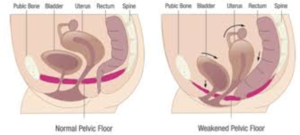
The pelvic floor muscles are situated at the base of the pelvis. They attach from the pubic bone at the front to the coccyx at the back, in a hammock-like formation. The pelvic floor muscles consist of both a superficial and deep layer.
When you activate your pelvic floor, you are squeezing both layers. The first part is where you squeeze like you’re trying to stop the flow of wind and urine (superficial), the second part is where you lift up like you’re about to lift up an imaginary tampon (deep).
The pelvic floor muscles are responsible for:
· Supporting the pelvic organs (bladder, uterus, rectum)
· Relaxing to expel urine, wind & faeces
· Contracting to hold in urine, wind & faeces
· Aiding in sexual function
· Working with deep core muscles to support the pressure in the abdominal cavity
Your pelvic floor muscles can weaken, particularly as you progress through your pregnancy due to the gradual increase in the weight of the baby, placenta and extra fluid. Imagine an empty hammock hanging between two trees, if you put something heavy in the hammock, the hammock will descend downwards. Similarly, this is what happens to the pelvic floor muscles and fascia.
Your pelvic floor muscles can also become weak due to:
· Giving birth
· Menopause
· General ageing
· Post abdominal or pelvic surgery
· Being overweight/obese
· Chronic coughing
· Constipation
If your pelvic floor muscles weaken, you may notice symptoms such as unexpected leakage, decreased sensation in your vagina, a strong and sudden urge to pass urine or vaginal heaviness.
If you have pelvic floor concerns, ensure you book a consultation with a trained Women’s Health Physiotherapist for an individualised assessment.
